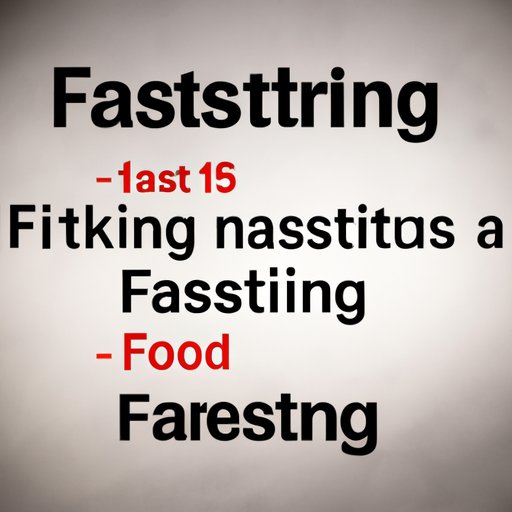
Introduction
One of the most popular weight loss methods today involves fasting, but with so many conflicting opinions and information out there, it can be hard to determine the optimal fasting period for maximum weight loss. While fasting can be a beneficial and effective way to shed unwanted pounds, there are various factors to consider to achieve successful and sustainable results. This article aims to provide insight into determining the optimal fasting period to maximize weight loss, based on individual factors such as age, weight, gender, physical activity levels, and more.
How to Determine the Optimal Fasting Period to Maximize Weight Loss
The ideal fasting period for weight loss depends on a variety of factors unique to an individual; factors like age, weight, gender, and physical activity levels should be taken into consideration when determining the optimal fasting period for the desired results. Typically, a 24-48 hour fast is followed by a period of recovery, however, it’s best to listen to your body and adjust the fasting period accordingly. Prolonged fasting periods may lead to muscle loss and other health risks. Likewise, shorter fasting periods may not produce the desired results for some people. Ultimately, proper nutrition and healthy habits complementing the fasting period will determine the level of success for the individual.
The Science Behind Fasting: How Long is Too Long for Effective Weight Loss?
Fasting induces weight loss by initiating a metabolic process known as “ketosis,” that burns fat for energy rather than glucose. The ideal duration for this process is generally between 12-48 hours, depending on individual circumstances. Prolonged fasting periods can lead to muscle loss, decreased metabolism and more health risks. It’s important to prioritize your health during fasting and listen to the signals your body sends to determine the appropriate duration. Nutrient-rich foods that promote a long-term supply of glucose are essential for the body to function normally during the fast. Consulting a doctor is often recommended, especially for individuals with underlying health conditions.
Different Types of Fasting: Which Method is Best for Your Weight Loss Goals?
There are various types of fasting to choose from when it comes to weight loss. Intermittent fasting or alternate-day fasting are the most popular methods. The 16:8 method is another type of intermittent fasting, where one eats within an 8-hour period andfasts for 16 hours each day. Each method has its own pros and cons, and what works for one might not work for another. It’s essential to learn about the variations and choose one that is in alignment with personal goals. Factors that should be considered when choosing the appropriate method include daily routine, schedule, and exercise routines.
Fasting for Weight Loss: Why Shorter Periods might be More Effective than Extended Ones
Despite the belief that longer fasting periods lead to more weight loss, shorter periods may be more effective for some individuals. The 16:8 method of intermittent fasting, for example, has shown to assist with weight loss without producing the negative side effects that accompany prolonged fasts. It’s vital to understand the role of nutritional balance, body requirements, and personal goals when selecting the ideal fasting period. This is where consulting with a doctor or dietitian is helpful.
The Pros and Cons of Different Fasting Periods for Achieving Your Weight Loss Goals
There are multiple variations to choose from when it comes to fasting, and each comes with its own distinct pros and cons. Longer fasting periods may lead to more significant weight loss, but may also decrease metabolism and the ability to perform daily activities. On the other hand, shorter fasting periods might not lead to significant weight loss but may help maintain weight for longer periods. Ultimately, sustainability and effectiveness depend on the individual’s metabolism, digestive system, and overall health. It is best to consult with a doctor to determine the appropriate fasting period for individual goals.
Maintaining Nutrient Balance While Fasting: Exploring the Ideal Length of a Fast for Healthy Weight Loss
Maintaining nutrient balance is essential while fasting, as the body requires essential elements to perform daily functions. Fasting periods of 16-48 hours are generally considered safe for both effective and healthy weight loss; anything more may not produce significant results and may lead to health consequences. Incorporating nutrient-rich foods and drinks like water, tea, and bone broth, and breaking the fast with healthy high-fiber foods helps one maintain a good supply of glucose while promoting long-term weight loss.
Tips for Choosing the Right Fasting Schedule for Your Body and Lifestyle to Achieve Sustainable Weight Loss
Choosing the right fasting schedule involves thinking ahead, paying attention to signals from the body, and only making changes gradually. Finding the right method of fasting involves understanding personal goals and lifestyle. It’s important to incorporate plenty of nutrient-rich foods during the eating periods to continue fueling the body for maximum effectiveness. Finding a pattern and sticking to it until getting the desired result is important. Lifestyle changes and long-term diet plan incorporating the fasting schedule into daily life is pivotal for creating sustainable habits that support achieving optimal weight.
Conclusion
Determining the optimal fasting period requires a great deal of introspection, attention to the body’s signals, and a willingness to experiment with different fasting periods. While there is no one-size-fits-all solution, various guidelines are available that take into account individual factors and goals. Understanding the different types of fasting, their pros, and cons, and the importance of nutritional balance is important when making any changes. A doctor’s support is often recommended to ensure the health of the individual. Ultimately, finding the right fasting period that aligns with one’s health goals, anatomy, life schedule, and routine is essential for achieving sustainable weight loss through fasting.




